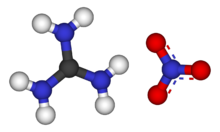Chemistry:Guanidine nitrate

| |

| |
| Names | |
|---|---|
| IUPAC name
Guanidinium nitrate
| |
| Identifiers | |
3D model (JSmol)
|
|
| ChemSpider | |
| EC Number |
|
PubChem CID
|
|
| RTECS number |
|
| UNII | |
| UN number | 1467 |
| |
| |
| Properties | |
| CH6N4O3 | |
| Molar mass | 122.1 |
| Appearance | White solid |
| Density | 1.436 g/cm3 |
| Melting point | 216 °C (421 °F; 489 K) |
| Boiling point | Decomposes commencing at 240 °C |
| 160 g/L at 20 °C | |
| Hazards | |
| Safety data sheet | MSDS |
| GHS pictograms |   
|
| GHS Signal word | Danger |
| H272, H302, H315, H318, H319, H332, H335 | |
| P210, P220, P221, P261, P264, P270, P271, P280, P301+312, P302+352, P304+312, P304+340, P305+351+338, P310, P312, P321, P330, P332+313, P337+313, P362, P370+378, P403+233, P405, P501 | |
| NFPA 704 (fire diamond) | |
Except where otherwise noted, data are given for materials in their standard state (at 25 °C [77 °F], 100 kPa). | |
| Infobox references | |
Guanidine nitrate is the chemical compound with the formula [C(NH2)3]NO3. It is a colorless, water-soluble salt. It is produced on a large scale and finds use as precursor for nitroguanidine,[1] fuel in pyrotechnics and gas generators. Its correct name is guanidinium nitrate, but the colloquial term guanidine nitrate is widely used.
Production and properties
Although it is the salt formed by neutralizing guanidine with nitric acid, guanidine nitrate is produced industrially by the reaction of dicyandiamide (or calcium salt) and ammonium nitrate.[2]
It has been used as a monopropellant in the Jetex engine for model airplanes. It is attractive because it has a high gas output and low flame temperature. It has a relatively high monopropellant specific impulse of 177 seconds (1.7 kN·s/kg).[note 1]
Guanidine nitrate's explosive decomposition is given by the following equation:
- [math]\ce{ [C(NH2)3]NO3 (s) -> 3 H2O (g) + 2 N2 (g) + C (s) }[/math]
Uses
Guanidine nitrate is used as the gas generator in automobile airbags.[3] It is less toxic than the mixture used in older airbags of sodium azide, potassium nitrate and silica (NaN3, KNO3, and SiO2), and it is less explosive and sensitive to moisture compared to the very cheap ammonium nitrate (NH4NO3).[4]
Safety
The compound is a hazardous substance, being an explosive and containing an oxidant (nitrate). It is also harmful to the eyes, skin, and respiratory tract.[2]
Notes
- ↑ 1000 lbf/in2 (700 kPa) chamber pressure, 14.7 lbf/in2 (101 kPa) exit pressure, shifting equilibrium theoretical performance.
- ↑ E.-C. Koch, Insensitive High Explosives: III. Nitroguanidine - Synthesis - Structure - Spectroscopy- Sensitiveness, Propellants Explos. Pyrotech. 2019, 44, 267-292.https://onlinelibrary.wiley.com/doi/10.1002/prep.201800253
- ↑ 2.0 2.1 Thomas Güthner, Bernd Mertschenk and Bernd Schulz "Guanidine and Derivatives" in Ullmann's Encyclopedia of Industrial Chemistry, 2006, Wiley-VCH, Weinheim. doi:10.1002/14356007.a12_545.pub2
- ↑ Tabuchi, Hiroko (2016-08-26). "A Cheaper Airbag, and Takata's Road to a Deadly Crisis (Published 2016)" (in en-US). The New York Times. ISSN 0362-4331. https://www.nytimes.com/2016/08/27/business/takata-airbag-recall-crisis.html.
- ↑ Halford, Bethany (November 15, 2022). "What chemicals make airbags inflate, and how have they changed over time?". Chemical & Engineering News 100 (41). https://cen.acs.org/safety/chemicals-make-airbags-inflate-changed/100/i41. Retrieved 4 June 2023. "The chemical reaction used to deploy airbags has evolved, but one iteration resulted in massive recalls".

External links
- Jetex: Propellants
- PhysChem: Guanidine Nitrate MSDS
 |


